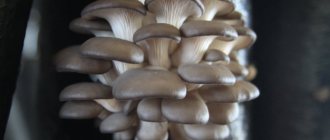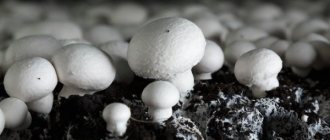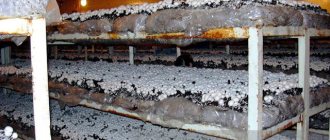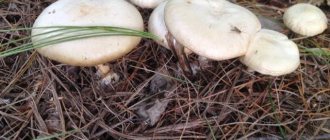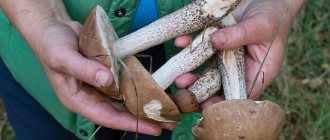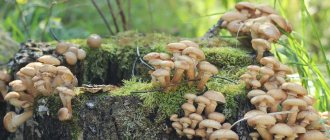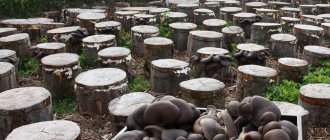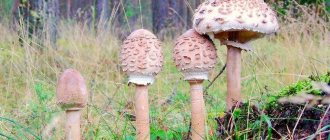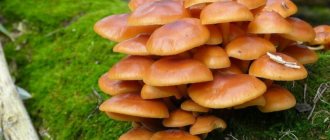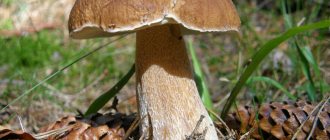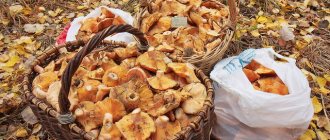You can grow champignons in a private house, namely in the basement (cellar), because its microclimate ideally meets all the requirements necessary to obtain a good mushroom harvest.
If your house does not have an underground space, a garage will do; mushrooms also grow well there. The main thing in this matter is to create optimal conditions, carefully treat the room, properly prepare the substrate and know the technology for growing mycelium. We will examine all these questions in detail in our article.
Champignon varieties for growing in the basement
For growing champignons in the basement, unpretentious varieties that are easy to care for and have high yields are perfect (for example, boles of meadow, double-spored or double-ringed champignons). Let's look at the most profitable of them:
- Hauser A15 is a hybrid with high yields, capable of growing on all types of substrate. It has large fruiting bodies (about 15 cm) and dense pulp.
- Somicel 512 is characterized by stable fruiting and several waves of harvest. Unlike the previous variety, it has smaller fruiting bodies, but despite this, it is especially popular among mushroom growers.
- Silvan 130 is characterized by fast germination and high yields. Suitable for planting on any type of compost, ideal for conservation.
Preparing the premises
The basement must be clean and isolated from external influences, have brick walls, a concrete floor, not an earthen one. When preparing an underground room, special attention should be paid to the following points:
Zoning
It is recommended to divide the room into zones using partitions, each of which will have individual lighting and air temperature. This is especially important if you plan to grow multiple varieties of mushrooms.
Shelving
To grow champignons, you should prepare racks and containers. You can buy them or make them yourself. It is best when the structures are made of plastic, unlike wood and metal, they are not subject to rotting, corrosion processes, are not afraid of moisture and mold, and are also characterized by great strength.
Lighting
In the basement it is necessary to purchase diffused fluorescent lamps to illuminate the room for 12-13 hours a day.
Microclimate
To successfully grow mushrooms in the basement, it is very important to maintain a certain microclimate.
To monitor the humidity level and air temperature, it is recommended to purchase a hydrometer and thermometer. The optimal humidity value should be between 65% and 95%. You can increase the humidity by spraying from a spray bottle, and lower it by ventilating. The air temperature should be no lower than 15°C and no higher than 29°C, depending on the stage of mushroom growth.
It is also necessary to install a ventilation system and an exhaust hood that improves access to fresh air. It is best to cover holes and pipes for ventilation with mesh material with small cells. This will protect the room from the penetration of harmful insects.
Another important point is the installation of additional heating to maintain the desired air temperature in winter. For heating in this case, a water system with a temperature controller is perfect; it is quite economical, easy to install and does not dry out the air.
Disinfection
To avoid the appearance of mold, mildew and pest attacks in the room, it is necessary to disinfect:
- Whitewashing walls, ceilings and other surfaces with 2-3 kg of slaked lime with the addition of 100 grams of copper sulfate, diluted in 10 liters of water.
- Irrigation of the walls of the room with 350 grams of bleach, diluted in 10 liters of water. This method is considered very dangerous for the human respiratory tract.
- Treating walls and other indoor surfaces with 4% formaldehyde using a construction sprayer.
- Fumigating a room using a sulfur bomb.
- Treating the room with chlorophos if vegetables were previously stored in the basement/cellar. This drug destroys mold and insect pests, but is considered the most destructive and poisonous.
After disinfection, the room must be ventilated. Before each new planting of mushrooms, the room should be treated with an antiseptic.
Recruitment
Naturally, in this case, you can do a lot yourself. But with large volumes you cannot do without workers. This will not be a problem because the process, although it requires care and precision, is not overly complex or high-tech. You may need workers for heavy work - stuffing bags, for example, loading, delivery. Same for routine care. At the first stage, in the absence of profit, it is advised to hire workers only for heavy work, and control the rest yourself. At the same time, workers can be hired under a civil contract rather than under an employment contract, which greatly facilitates the conduct of business.
Substrate preparation
The substrate for growing champignons should be loose and nutritious, slightly springy and soft, with an acidity level of 7.3-7.5 pH. To get a good harvest of mushrooms, you should prepare it according to the instructions.
Depending on the type of champignon, the preparation methods and compositions of compost may be different. But there are basic principles for its preparation as a universal one. The best option is compost made from horse manure. It is recommended that animals eat hay rather than green food.
1 composition:
horse manure (with a high straw content and a moisture content of 40-45%) - 850 kg;
- gypsum – 18 kg;
- urea – 3 kg;
- ammonium nitrate – 8 kg;
- superphosphate – 13 kg
2 composition:
- horse manure – 2 thousand kg;
- chalk – 7.5 kg;
- straw – 50 kg;
- urea – 5 kg;
- ammonium sulfate – 8 kg;
- superphosphate – 5 kg.
Horse manure can be replaced with cow or poultry manure, but in this case the harvest will be worse. After preparing all the necessary ingredients, you need to soak the straw in warm water for 2 days. Then it is placed in a pile mixed with layers of manure. In total you should get 6-8 layers, each of which needs to be moistened with warm water.
After a few days, the compost should be thoroughly mixed, and then urea and superphosphate should be added. After another 3-4 days, the compost is mixed again and the remaining ingredients are added. Finally, during the last mixing, gypsum and chalk are added.
It is best to prepare the substrate in a special utility room with good ventilation, or outdoors under a canopy that will protect it from sunlight and precipitation.
On average, compost preparation takes 24-28 days. Ready humus is characterized by the absence of ammonia odor and light brown color. To grow mushrooms, the compost temperature should be no more than 25 degrees.
The finished substrate must be moved to the basement and placed in boxes or containers in which it is planned to grow champignons.
If you find it too difficult to make your own compost, you can always buy it at the store, but homemade compost is of better quality.
Selection of mycelium
Mycelium, in other words mycelium, is an important organ without which it is impossible to grow mushrooms. Mycelium can be grain and compost:
- Grain is sold in plastic bags and stored for about six months at a temperature of 0-4°C. Among its advantages is that it is convenient to sow and does not need to be processed.
- Compost is sold in glass jars and stored for about a year at a temperature of 0-4°C. Compared to grain mycelium, it is less productive, but not as sensitive to changes in temperature and humidity.
Mycelium can be purchased in special stores. A quality product should have a yellow color with an orange tint and smell like fresh mushrooms. You should not buy mycelium with dark spots (they indicate the presence of mold) and an ammonia smell (this means that the product was not stored correctly and has deteriorated).
If you have not found a supplier from whom you can purchase ready-made mycelium, you can collect it from areas where wild mushrooms grow. But do not collect mycelium in environmentally unfavorable areas and near busy roads, this can be hazardous to health. Collect soil with thin, young bluish mycelium (thick yellowish mycelium will not work).
You can also grow mycelium yourself at home. This will require a lot of effort, but in this case you will definitely be confident in the quality of the product.
Under what conditions does oyster mushroom fruiting occur?
Agricultural conditions are created in order to achieve maximum yield with minimal loss of time and product quality.
The terms read as follows:
- You should carefully monitor the room temperature; it should be 22-24 degrees Celsius. The temperature of the substrate itself should not exceed +28C, and air humidity 90-95 percent.
- Standard humidifiers should be used to maintain room humidity. At home, you can place containers of water between the mycelium.
- You only need to irrigate the air, avoiding moisture getting on the bags. Even small puddles on the floor should be wiped up.
- Oyster mushroom needs good ventilation and fresh air. The carbon dioxide content in the room should not exceed 1 percent.
Do not forget to use upper respiratory protection indoors, since when fruiting, the spores cause serious allergies and coughing.
Planting mycelium and caring for it
You need to prepare holes in the substrate, located in a checkerboard pattern at a distance of 20 cm from each other. A pinch of mycelium should be placed in each hole, deepening it 5 cm, and then filling it with soil. If you sow grain fungal spores, they should be spread over the surface of the soil without being covered with soil.
After this, the soil is covered with cloth or newspapers, which will then need to be regularly moistened with a spray bottle to maintain high humidity. You cannot water the champignons; water should not get into the compost.
For 1 m2 of substrate you will need 0.5 m2 of compost mycelium or 400 grams of grain. For 5 days, while the mycelium grows, the air temperature in the room should be 24-26 degrees, and the humidity level should be 80-95%.
5-10 days after planting, when white threads appear (a sign of proper development of the mycelium), the surface is covered with limestone, soil and peat in a ratio of 1:4:5, 3-4 cm thick. This will provide additional protection for the mycelium from drying out and obtain a high-quality harvest. .
After this, the boxes with mushrooms should be taken to a cooler part of the room with an air temperature of 13-16 degrees. If the air temperature exceeds 16 degrees, this will negatively affect the quantity and quality of the future harvest.
Obtaining mycelium
As we noted earlier, anyone can purchase mushroom mycelium without spending time and effort on its production. However, there are also disadvantages to purchasing the material:
- Additional financial expense;
- Lack of confidence that the acquired mycelium is of the highest quality, which directly affects the yield.
That is why we will tell you how to get mycelium with your own hands.
- You will need whole, fresh oyster mushrooms or their fragments. Mushrooms are cleaned of germs and foreign microorganisms using ordinary hydrogen peroxide.
- After processing, the stage of transferring the sterile raw material into a test tube follows, in which the mycelium will further develop. It is important to carry out manipulations over a fire flame - this eliminates contamination by irritants from the environment.
- The mycelium is kept in a nutrient medium (optimally potato or oat agar) for 15-20 days. The room should be dark and warm (+23-24 degrees).
After the specified time, the mycelium can be planted in the substrate.
For information! There are several dozen varieties of oyster mushrooms found in nature, but only a few of them are commonly cultivated: oyster, common, pink, K-12/NK-35/R-20.
The listed representatives are edible and are characterized by high yields, which is beneficial for those who decide to engage in agricultural business.
Harvesting
Harvest can be done 3-4 weeks after planting the mycelium. You need to collect large and medium-sized mushrooms with the membrane intact, twisting them out of the ground. You cannot cut champignons, otherwise you can introduce diseases into the mycelium or damage nearby mushrooms. The holes left from the collected mushrooms on the substrate must be filled with a special soil mixture.
If all growing conditions and technologies are properly observed, you can get up to 7 mushroom harvests. But one should take into account the fact that only the first 3 harvests will be the most abundant, the rest will bear fewer fruits due to the gradual reduction of mycelium resources.
When the yield decreases, the mycelium is removed (later it is used as feed for the next generation), and the substrate is disposed of, because it cannot be reused; it loses its fertile properties.
Features and advantages of growing mushrooms in the basement
If desired, even a beginner can cope with growing mushrooms in the basement. Over time, this can become not just a pleasant hobby, but also a way to earn money. After all, growing champignons is considered a very profitable business, which has its own advantages:
- You can grow mushrooms in the basement all year round, the main thing is to create the necessary conditions for this;
- No special knowledge is required to grow champignons; anyone can do it;
- mushrooms do not require much time and attention;
- there is no need to pay rent for the premises, because... there is a basement in almost every private house;
- Growing mushrooms in the basement does not require large financial investments, because... Most of the materials needed to grow them are inexpensive.
Arranging the basement, adjusting the microclimate and monitoring the sanitary situation are the only difficulties you will have to face.
Possible risks
Growing mushrooms has its own risks, disadvantages and pitfalls, which are often hidden in the nuances. They can significantly reduce the profitability of your business.
What can negatively affect the final profit:
- Special culinary preferences of people in your region . In different parts of our country, the amount of purchased mushrooms consumed varies, sometimes significantly. This is explained by the fact that some potential consumers prefer wild mushrooms, while others, for a number of reasons, rarely or do not eat them at all.
- High competition. Before you start growing mushrooms for sale, study this market in detail. Suddenly it turns out that the competition is so tough that it will not be possible to turn a profit.
- Difficulty of sales. Mushrooms are in demand while they are fresh. If you have a modest customer base and small orders, there is a risk of not having time to sell a fresh product. And a weathered product loses both taste and presentation, which will directly affect subsequent sales and your reputation.
Business plan
As we said earlier, growing champignons is a profitable business that does not require large financial investments. But here, of course, everything depends on the resources you have and the planned production volumes.
When organizing a business, many entrepreneurs have to spend considerable sums on purchasing equipment. To grow champignons you only need to purchase:
- raw materials for the production of 1 ton of substrate - 1000-1500 rubles;
- mycelium – 500-1000 rubles;
- equipment for creating the necessary conditions in the basement - 2000-3000 rubles.
The result is 3500-5500 rubles. This is not such a big amount to start your own business.
Summary
As you can see, growing porcini mushrooms as a business has a characteristic feature: there is a lot of money involved (every year it amounts to millions), but the relative profit is very modest (the profitability of the process is 22%). At the same time, the total harvest reaches 8 tons per year of mushrooms alone, and after each harvest wave it is necessary to remove and refill substrate bags (this is another 8 tons 6 times a year).
The largest cost item is the mycelium. Each time it needs to be sown anew, without the possibility of reuse... So for those who would like to do easier work, maybe it makes sense to consider the possibility of organizing a business for growing and selling the mycelium of porcini mushrooms itself?.. However, this is a completely different idea .
Anna Kravets
Woman entrepreneur, sales specialist. I am always interested in new directions and opportunities in business and online entrepreneurship.
